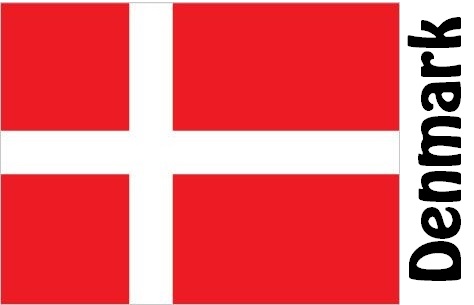Flags of Countries that Start with D
How many countries beginning with D? There are a total of 5 countries starting with letter D among the 193 countries in the world:
- Democratic Republic of the Congo
- Denmark
- Djibouti
- Dominica
- Dominican Republic
Denmark

Denmark is a kingdom in Northern Europe N for Germany. Denmark includes the peninsula of Jutland as well as over 400 other islands. Zealand, Funen and Bornholm. Greenland and the Faroe Islands form a rich community with Denmark. The Danish landscape is flat or slightly hilly. The surface consists mainly of moraine deposits. Only on Bornholm you see the bedrock.
The climate is temperate with mild winters and cool summers.
The most important natural resources are good agricultural land, oil, natural gas, salt and limestone. Agriculture, fisheries and and high-tech industrial production and research are essential for the economy.
Denmark has a well-developed democracy, one of the world’s most developed welfare systems and a high standard of living. The country is a member of the EU and NATO, but is outside the euro.
Country Facts – State Capital – Population Graph – Airports – Public Holidays – Embassies of Denmark – Embassies in Denmark – Import Regulations – Major Trade Partners – Major Imports – Major Exports
Dominica

The Republic of Dominica is an eastern state of the eastern Caribbean. The island is the northernmost of the Windward Islands in the Lesser Antilles. Dominica is a volcanic and mountainous island with rainforest, volcanic craters, steep coasts, hot springs, waterfalls and rivers.
The climate is tropical and dominated by the northeast pass and large amounts of rainfall. Hurricanes occur frequently.
Especially bananas, coconuts, citrus fruits, cocoa and cinnamon are grown and exported. In addition to fertile farmland, Dominica has only a few natural resources. Tourism is growing.
Dominica became French colony in 1632, later British. In 1978, the country became independent. The population consists mainly of descendants of slaves from Africa. The island’s Native American population lives in a reserve.
Country Facts – State Capital – Population Graph – Airports – Public Holidays – Embassies of Dominica – Embassies in Dominica – Import Regulations – Major Trade Partners – Major Imports – Major Exports
Dominican Republic

The Dominican Republic is located in the Caribbean and includes the eastern 2/3 of the island of Hispaniola. The landscape consists of mountains, fertile plains and valleys, forests in the N and O, grasslands in the SE, a large coastal plain in the island and the salt lake Enriquillo in the V, near the border with Haiti.
The climate is warm and tropical with very large amounts of rain. Hurricanes occur frequently.
Service and agriculture are central to the Republic’s economy. In particular, sugar, coffee, cocoa and tobacco are grown and exported. The country also mines nickel, bauxite and salt. Tourism is growing.
The country has been very poor in the past, but today the economy is growing. However, there is still a big difference between rich and poor.
Country Facts – State Capital – Population Graph – Airports – Public Holidays – Embassies of Dominican Republic – Embassies in Dominican Republic – Import Regulations – Major Trade Partners – Major Imports – Major Exports
Democratic Republic of the Congo

The Democratic Republic of Congo is located in Central Africa. The landscape consists of high mountain ranges in the island, low mountains and high plains in the rest of the country as well as a narrow strip of swampy lowland out to the Atlantic Ocean. About 3/4 of the country’s area is covered by tropical rainforest.
The climate is tropical with rainy season April-October in N and November-March in S.
The country is very rich in natural resources. copper, diamonds, cobalt and oil. There is also great potential for hydropower. Agriculture employs over 50% of the working population.
Belgian colony (Belgian Congo) until 1960. Civil war, war, rebellion and political unrest continue to plague the country and hamper the economy. The country was named the Democratic Republic of Congo in 1997.
Country Facts – State Capital – Population Graph – Airports – Public Holidays – Import Regulations – Major Imports – Major Exports
Djibouti

Djibouti is a republic in East Africa on the Gulf of Aden and the entrance to the Red Sea. Djibouti’s landscape consists of low-lying sand and rock desert, mountains, highlands and salt lakes. The Salt Lake Assal is Africa’s lowest point (- 173 m).
Djibouti is one of the hottest and driest countries in the world. The climate is desert-like. Frequent small earthquakes.
The country has few natural resources. However, salt is extracted from salt lakes and there is a large animal husbandry. The economy is mainly based on trade, service and transport via the port and railway between Djibouti and Addis Ababa (Ethiopia).
Former French colony until 1977, when the country became independent. Djibouti is a poor and politically unstable country that receives financial assistance, especially from France and Saudi Arabia.

Country Facts – State Capital – Population Graph – Airports – Public Holidays – Embassies of Djibouti – Embassies in Djibouti – Import Regulations













































